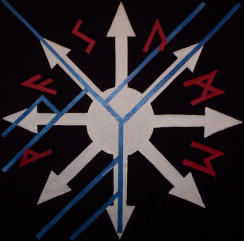One day around the turn of the century I was driving down the M1 motorway to a meeting in London. I was listening to Radio 4, and an item came on about church singing on the Hebridean Isle of Lewis, off the west coast of Scotland. They were singing Gaelic psalms, powerful voices weaving together like knot-work, spilling over each other in what the presenter described as ‘waterfall singing.’ One voice would start then others would join in, improvising rich polyphony on a simple basic tune.
The sound was incredible. This music was uplifting, mysterious, scalp-tinglingly visceral. Here is a sample.
At some point it occurred to me that this is how runes should be sung in a group. Who knows, maybe our ancestors sang runes in this way? Or maybe not. But in any event, as soon as I’d made that connection, I couldn’t wait to start.
Waterfall Galdor and WASUME
Over the next few years I introduced the practice to various groups of chaos magicians. In 2005, at the Rune-Gild World Moot in Schleswig, I introduced to technique to other Gilders.
In the winter of 2007 I joined with a larger group, maybe 12 people, in an underground temple in Austria, with a glass roof supported by six wooden beams that formed a Hagal snowflake under the full moon. The acoustics were amazing, and the effects astonishingly intense, one of the best magical sounds I have ever heard.
Back in Sheffield, my chaos magic group WASUME took up the practice with alacrity. One of our number – George Rogers – is a musician and as we developed the technique of working our four voices together, George recorded a good deal of it. We used waterfall galdor for our own magical workings and also started using it in performances. One of the earliest was in 2012, the launch of my novel The Road To Thule. This was in an upstairs room at the great but since-departed independent bookshop Rare and Racy. This is part of the flyer for the event:
WASUME
(pronounced wa-soo-may) consists of four people who sing magic.
WASUME’s singing styles and techniques are developed from ancient European forms that survive today: Gaelic psalm-singing, the beat frequencies captured by drifting microtones, the eerie harmonics of the Sardinian ‘Quintina’.
Our speciality is galdor, the singing of runes, the magical alphabets of the Northern peoples. WASUME sing these spells using cascading harmonies derived from the ‘waterfall singing’ of Gaelic psalms, the last surviving example of a singing style believed to have been heard all over Europe centuries ago.
The galdors WASUME sing are built up from galdors of individual runes. First the individual runes are sung, then the bind-rune, the ‘word’ formed from the runes. The leader introduces the galdor and the other singers follow, using the same notes and sometimes harmonies or microtones around them. Our own name, WASUME is a bindrune.

Recording
This recording is by George Rogers and features WASUME singing the bindrune-formula WUALF, designed by Peter Mastin. It’s a formula to transmit higher consciousness, health, wealth and good fortune.
Practice
For now, here are some instructions for Waterfall Galdor:
- If you haven’t already, practice singing runes on your own;
- Find another person or persons, practice with them;
- Go for the same note, then veer off a semitone and listen for beat frequencies;
- Listen to what the other person/s are singing;
Sing with more people if you can
___________________________
D. Lee, Sheffield, GB
